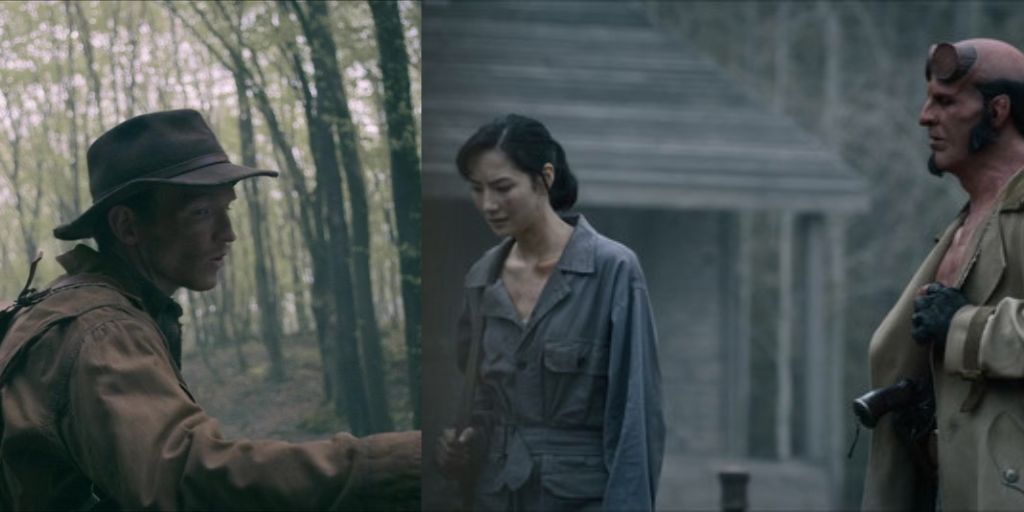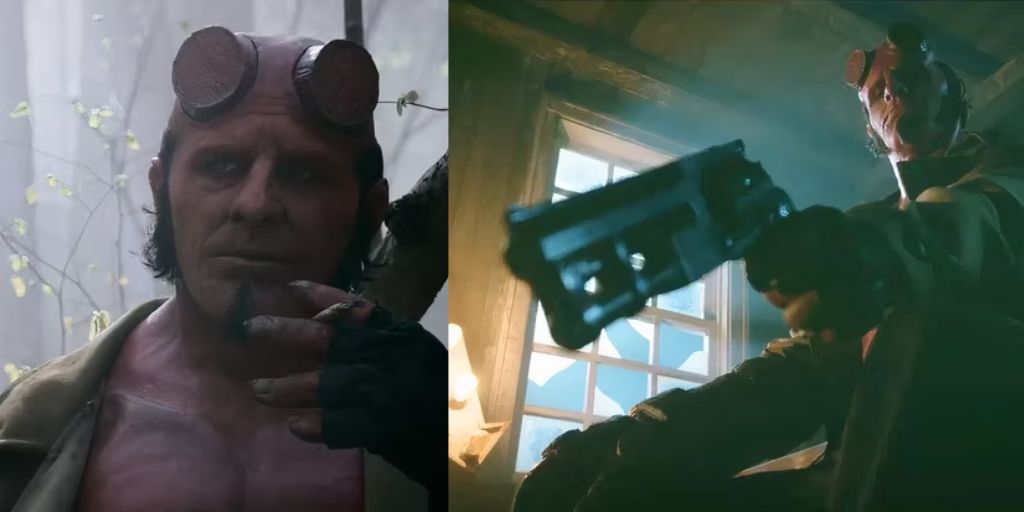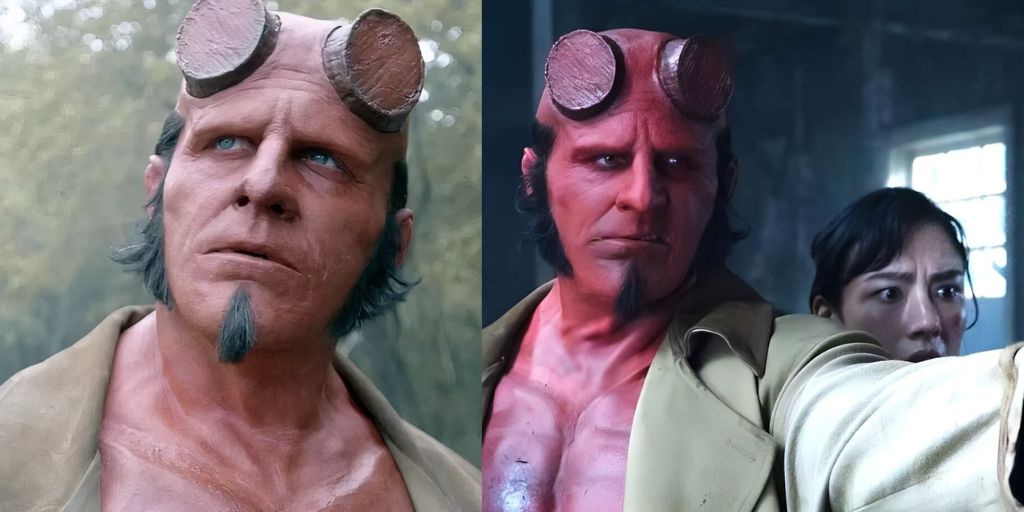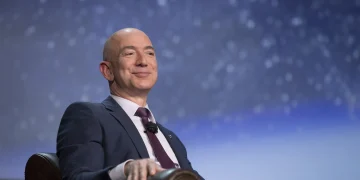Hellboy: The Crooked Man marks a new journey for one of the most beloved comic book characters. This latest film is the fourth live-action adaptation of Hellboy, a character who first became popular thanks to the two Guillermo del Toro movies and later appeared in the 2019 reboot.
Despite Hellboy’s strong legacy, The Crooked Man didn’t receive much attention and was quietly released on video on demand (VOD). Surprisingly, many fans didn’t even know this new installment existed.
This new Hellboy movie, directed by Brian Taylor, brings a different perspective to the franchise. It is based on The Crooked Man graphic novel, which is considered one of the best works by Hellboy’s creator, Mike Mignola.
With a smaller, thriller-style approach, Hellboy: The Crooked Man tries to take the character back to his darker roots and breathe new life into the series. The film may not have made it to theaters, but it still offers a fresh and bold take on the iconic hero, despite some flaws.
A Brief Overview of Hellboy’s Cinematic History
Before we get into the specifics of The Crooked Man, it’s important to understand Hellboy’s journey on the big screen. Hellboy first appeared in two films directed by the visionary Guillermo del Toro. Hellboy (2004) and Hellboy II: The Golden Army (2008) were both well-received by critics and audiences alike.
Del Toro’s style mixed dark fantasy with unique visual elements, making Hellboy a fan favorite. Actor Ron Perlman’s portrayal of Hellboy was praised for capturing both the character’s humor and toughness.
In 2019, a reboot of the series was attempted with actor David Harbour taking over the role. Unfortunately, this reboot did not resonate with fans.
The movie was criticized for its messy storytelling, lack of direction, and full disappointing execution. This left the future of the Hellboy franchise in question. So, when The Crooked Man was announced, fans were cautiously optimistic.
What Is Hellboy: The Crooked Man About?
Hellboy: The Crooked Man takes a new direction, starting over with a fresh take on the character. The film is set in 1959, moving away from the modern cities seen in previous Hellboy movies. Hellboy, now played by Jack Kesy, finds himself in the Appalachian wilderness.
Accompanied by fellow BPRD (Bureau for Paranormal Research and Defense) agent Bobbie Jo Song (Adeline Rudolph), Hellboy must face a dangerous demon known as The Crooked Man (Martin Bassindale) after their train is derailed.
They are joined by a noble local named Tom Ferrell (Jefferson White), and together, the trio uncovers a story full of demonic witchcraft.
The atmosphere is foreboding and unsettling, enhanced by the haunting rural surroundings. This film transports Hellboy into uncharted territory, shifting away from the grand urban confrontations of previous installments and immersing him in a more personal, chilling journey.
The Budget Challenges of Hellboy: The Crooked Man
From the opening scene, one of the major issues with The Crooked Man becomes apparent—its low budget. The film suffers from some poorly executed CGI, especially early on. One of the first monsters we see looks unconvincing, which might put off some viewers. Budget limitations continue to affect the movie, with certain sequences feeling underdeveloped.
Still, The Crooked Man does manage to find moments of visual creativity, particularly through its practical effects. Hellboy’s iconic look, for example, is well-executed. The Crooked Man himself is suitably creepy, with his appearance closely resembling his comic book counterpart.
However, the inconsistency between the practical and digital effects does take away from the film’s immersion at times. The movie would have benefited from a larger budget to better realize its ambitious vision.
A New Hellboy – Jack Kesy’s Performance
One of the standout elements of The Crooked Man is Jack Kesy’s portrayal of Hellboy. While Ron Perlman’s version of the character remains a fan favorite, Kesy brings a fresh approach to the role.
Unlike Perlman’s Hellboy, who often disrespects authority, or David Harbour’s more chaotic take, Kesy’s Hellboy is calmer and more thoughtful. He is portrayed as a noir-style detective, staying closer to Mike Mignola’s original vision of the character in the comics.
Kesy’s Hellboy is more responsible, showing maturity while still delivering the dry humor and witty one-liners fans expect.

His performance offers a nice balance between the tough, action-hero persona and the cooler, calculated side of the character. Kesy may not dethrone Perlman as the definitive Hellboy, but his version is different enough to stand on its own and deserves recognition for bringing a new layer to the character.
Supporting Cast – A Mixed Bag
In addition to Kesy, Hellboy: The Crooked Man features a solid supporting cast. Adeline Rudolph and Jefferson White both do a decent job as Hellboy’s companions.
While Rudolph’s character, Bobbie Jo, gets caught up in an unnecessary subplot in the third act, her chemistry with Kesy and White helps keep the story engaging. White’s Tom Ferrell adds a sense of nobility and heart to the otherwise dark tale.
On the villain side, Leah McNamara and Martin Bassindale bring a sense of menace as the demonic antagonists. Bassindale, in particular, shines as The Crooked Man, delivering a chilling performance.
However, it’s Joseph Marcell as Reverend Watts who steals the show among the supporting cast. His portrayal of a blind evangelical priest is one of the more entertaining parts of the film, and he brings a lot of energy to his scenes.
The Horror Vibe – Effective but Not Fully Realized
Director Brian Taylor promised that The Crooked Man would be a different kind of Hellboy movie, and in many ways, he delivered. The film leans more toward horror than its predecessors, which were more focused on action and spectacle.
The Crooked Man creates a dark and eerie atmosphere, especially with its rural Appalachian setting and the demonic storyline. At times, the film feels closer in tone to something like Constantine than the previous Hellboy movies.
However, the horror elements don’t always hit the mark. The film relies on some cheap jump scares, which feel out of place, particularly toward the end. While the dark, supernatural themes are present, the movie sometimes struggles to maintain the tension needed for a truly effective horror experience.
Still, there are moments where the horror works, particularly in some of the practical effects scenes and the unsettling atmosphere in the Appalachian woods.
Budgetary Constraints – A Major Obstacle
As previously mentioned, the budget is one of the film’s biggest challenges. While the smaller scale is part of what makes The Crooked Man interesting, the lack of resources becomes apparent in several key moments. The film’s ambition outstrips its budget, and this leads to some underwhelming effects, particularly when it comes to CGI.
The practical effects, on the other hand, are much stronger. Hellboy’s makeup is as impressive as ever, and there are some creative practical sequences, including a memorable scene involving a skin suit.
But the digital effects, especially in the monster designs, often fall short. The contrast between the practical and digital elements creates a jarring experience, where some scenes feel immersive and others take the viewer out of the story.
A Step Forward or a Step Back?
Ultimately, Hellboy: The Crooked Man is a mixed experience. On the one hand, it offers a fresh take on Hellboy, with a new tone, setting, and a more responsible version of the character.
Jack Kesy’s performance is a highlight, and the film’s attempt to return to Hellboy’s darker, horror roots is commendable. The supporting cast does a decent job, and there are moments where the movie’s smaller scale works in its favor.
On the other hand, the low budget and inconsistent effects hold the film back. For every moment that works, there is another that feels underdeveloped or constrained by a lack of resources.

Fans of the original del Toro films may find The Crooked Man disappointing, especially since it doesn’t have the same visual flair or sense of spectacle.
For hardcore Hellboy fans, The Crooked Man offers enough to keep them engaged, especially with its fresh take on the character and darker tone. However, casual viewers or those looking for something closer to the original films may be left wanting more.
While The Crooked Man is an improvement over the 2019 reboot, it doesn’t quite reach the heights of the del Toro films. It’s a bold but flawed step in a new direction for Hellboy, and time will tell whether this new incarnation of the character will continue to develop or be left behind for another reboot in the future.





